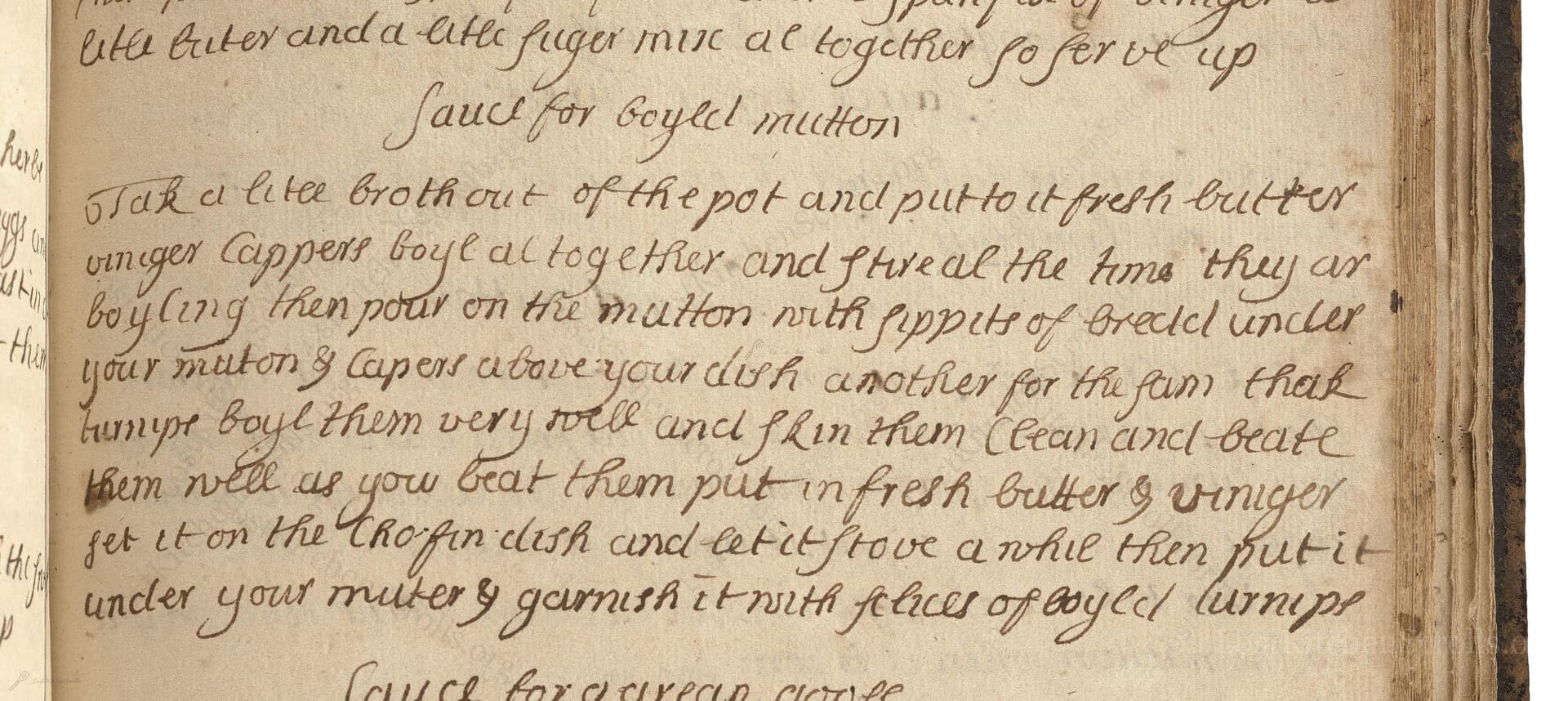Sauce For Boyled Mutton
From the treasured pages of Cookbook
Unknown Author

Sauce For Boyled Mutton
"Tak a litle broth out of the pot and put to it fresh butterr viniger & cappers boyle al together and stire al the time they ar boyling then pour on the mutton with sippits of breadel under your mutton & capers above your dish. another for the sam that turnype boyl them very well and skin them clean and beate them well as you beat them put in fresh butterr & viniger set it on the Chofin dish and let it stove a while then put it under your muter & garnish it with selices of boyled turnype"
Note on the Original Text
Like many period recipes, this is written in a terse, conversational style, assuming the reader's familiarity with basic kitchen techniques. Quantities are vague or absent, reflecting an oral culture and the skill of the cook to judge by eye and taste. Spelling is idiosyncratic: 'boyled' for boiled, 'sippits' for sippets, 'Chofin dish' for chafing dish, 'selices' for slices. The recipe gives options, encouraging adaptability. This approach lets cooks improvise using what was to hand, rather than following precise, printed measurements.

Title
Cookbook (1706)
You can also click the book image above to peruse the original tome
Writer
Unknown
Era
1706
Publisher
Unknown
Background
Step back to the early 18th century with this charming culinary collection, brimming with period recipes that tantalize the tastebuds and offer a delicious glimpse into historic kitchens.
Kindly made available by
Folger Shakespeare Library
This recipe hails from early 18th-century England, around 1706, found in a manuscript cookbook. Boiled mutton was a staple of British dining tables, prized for its simplicity and hearty nourishment. Sauces like these were developed to add flavour and richness, often making use of kitchen staples: a ladle of broth, a knob of butter, a splash of vinegar, and preserved capers for a punch of brininess. The mention of 'sippits'—crisp bread pieces—harkens back to the tradition of serving meats on bread, both to soak up juices and to make the meal more filling. The turnip variant captures another key aspect of historic English fare: adaptability and thrift, using locally abundant vegetables to make elegant accompaniments.

Cooks in 1706 would have used a large iron or copper pot for boiling the mutton. A small saucepan or pipkin served for preparing the sauce over the hearth. Wooden spoons for stirring, a strainer for lifting meat and vegetables, and a trencher or thick slices of bread for serving were standard. For the turnip purée, a heavy pestle or a wooden masher would have been used, with the sauce kept warm on a chafing dish or by the fireside.
Prep Time
10 mins
Cook Time
15 mins
Servings
4
We've done our best to adapt this historical recipe for modern kitchens, but some details may still need refinement. We warmly welcome feedback from fellow cooks and culinary historians — your insights support the entire community!
Ingredients
- 1/2 cup mutton broth (substitute: light chicken or vegetable broth if needed)
- 3 1/2 tbsp (1.75 oz) unsalted butter
- 1 tbsp (1/2 fl oz) white wine vinegar
- 2 tbsp (2/3 oz) capers (plus extra for garnish)
- Sippits: 2-4 slices of bread, toasted or fried until crisp
- For turnip sauce alternative:
- 10 1/2 oz turnips, peeled and chopped
- 1 1/2 oz fresh butter
- 1 tbsp (1/2 fl oz) white wine vinegar
- Slices of boiled turnip for garnish
Instructions
- To recreate this classic sauce for boiled mutton in a modern kitchen, begin by ladling about 1/2 cup of the mutton's cooking broth into a small saucepan.
- Add 3 1/2 tablespoons (about 1.75 ounces) of unsalted butter, 1 tablespoon (about 1/2 fluid ounce) of white wine vinegar, and 2 tablespoons (about 2/3 ounce) of capers.
- Bring to a gentle boil, stirring continuously so the butter emulsifies with the broth and vinegar, and the mixture thickens slightly.
- When ready, pour this sauce over boiled mutton slices arranged with toasted or fried bread pieces ('sippits') underneath.
- Scatter additional capers on top for garnish.
- The alternative turnip 'sauce' involves boiling roughly 10 1/2 ounces of peeled turnips until completely soft, then mashing or beating them thoroughly with 1 1/2 ounces of fresh butter and 1 tablespoon (1/2 fluid ounce) of vinegar.
- Gently heat this purée so it stays warm (a bain-marie or a gentle stove works well).
- Serve this turnip mash underneath slices of boiled mutton, garnished with thin slices of boiled turnip.
Estimated Calories
130 per serving
Cooking Estimates
Preparing this dish is fast and simple. You will need a few minutes to gather and measure your ingredients, plus cooking time for the sauce or turnips. Each serving delivers a comforting, classic taste with moderate calories.
As noted above, we have made our best effort to translate and adapt this historical recipe for modern kitchens, taking into account ingredients nowadays, cooking techniques, measurements, and so on. However, historical recipes often contain assumptions that require interpretation.
We'd love for anyone to help improve these adaptations. Community contributions are highly welcome. If you have suggestions, corrections, or cooking tips based on your experience with this recipe, please share them below.
Join the Discussion
Rate This Recipe
Dietary Preference
Main Ingredients
Culinary Technique
Occasions

Den Bockfisch In Einer Fleisch Suppen Zu Kochen
This recipe hails from a German manuscript cookbook compiled in 1696, a time whe...

Die Grieß Nudlen Zumachen
This recipe comes from a rather mysterious manuscript cookbook, penned anonymous...

Ein Boudain
This recipe comes from an anonymous German-language manuscript cookbook from 169...

Ein Gesaltzen Citroni
This recipe, dating from 1696, comes from an extensive anonymous German cookbook...
Browse our complete collection of time-honored recipes



